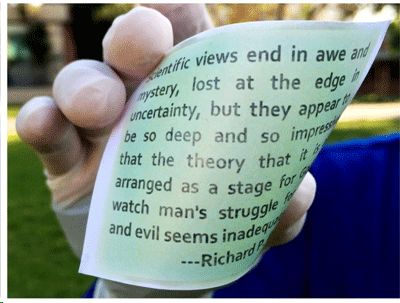|
NOVIDADES
Since its invention around 100 B.C. in China, paper as a material for spreading information has greatly contributed to the development and spread of civilization. Even in today’s information age, with electronic media omnipresent in homes, offices and even our pockets, paper still plays a critical role. Our brains process information differently on paper and on screen. Information presented on paper involves more emotional processing and produces more brain responses connected with internal feelings. That can make printed material more effective and more memorable than digital media. Of course, paper is still in common use, and global consumption is expected to grow.  Créditos: University of California, Riverside But paper use comes with significant environmental and sustainability problems. For many years, scientists have worked to develop reading media that have the format of conventional paper but can be reprinted without first having to be industrially recycled. One promising option has been to coat paper with a thin film of chemicals that change color when exposed to light. But previous efforts have encountered problems such as high cost and high toxicity – not to mention difficulty both remaining readable and being erased for reuse. My research group at the University of California, Riverside, in collaboration with Wenshou Wang at Shandong University in China, has recently developed a new coating for regular paper that needs no ink, and can be printed on with light, erased and reused more than 80 times. The coating combines the functions of two types of nanoparticles, particles 100,000 times thinner than a piece of paper; one particle is able to get energy from light and initiates color change of the other. This represents an important step toward the development of reprintable paper. Pulp extraction consumes large amounts of energy and can involve dangerous chemicals like dioxin. Paper production results in the emission of the nutrient phosphorus. That, in turn, boosts plant growth, which can use up all the oxygen in the water and kill any animal life. Even after paper is made, its use damages the environment. Trucking paper from where it’s made to where it’s used generates air pollution. And making and using ink and toner also harm the environment, by contaminating water, poisoning soil and destroying the natural habitats of wildlife. Our method uses nontoxic ingredients and permits repeated reuse of paper, thereby reducing the environmental effects. Our method combines nanoparticles – particles between 1 and 100 nanometers in size – of two different materials that can change from clear to visible and back again. The first material is Prussian blue, a widely used blue pigment most familiar as the blue color in architectural blueprints or inks. Prussian blue nanoparticles normally appear blue, of course, but can become colorless when they are supplied with additional electrons. The second material is nanoparticles of titanium dioxide. When exposed to ultraviolet light, they release the electrons the Prussian blue needs to turn colorless. Our technique combines these two nanoparticles into a solid coating on conventional paper. (It can also be applied to other solids, including plastic sheets and glass slides.) When we shine ultraviolet light on the coated paper, the titanium dioxide produces electrons. The Prussian blue particles pick up those electrons and change color from blue to clear. The printing can be done through a mask, which is a clear plastic sheet printed with letters and patterns in black. The paper starts out entirely blue. When UV light passes through the blank areas on the mask, it changes the corresponding areas on the paper underneath into white, replicating the information from the mask to the paper. The printing is fast, taking only a few seconds to complete. The resolution is very high: It can produce patterns as tiny as 10 micrometers, 10 times smaller than what our eyes can see. The paper will remain readable for more than five days. Its readability will slowly degrade, as the oxygen in the air takes electrons from the Prussian blue nanoparticles and turn them back to blue. The printing can also be done using a laser beam, which scans across the paper surface and exposes the areas that should be white, in a way similar to how today’s laser printers work. Erasing a page is easy: Heating the paper and film to about 120 degrees Celsius (250 degrees Fahrenheit) speeds up the oxidation reaction, erasing the printed content completely within about 10 minutes. This temperature is far lower than the temperature at which paper ignites, so there is no danger of fire. It is also lower than the temperature involved in current laser printers, which need to reach about 200 degrees Celsius (392 degrees Fahrenheit) to instantly fuse the toner onto the paper. By contrast, Prussian blue molecules remain essentially intact even after long-term exposure to ultraviolet light. In our lab, we have been able to write and erase a single sheet more than 80 times without observing any apparent changes to the intensity of the color or the speed of the switch. In addition, Prussian blue can be easily modified to produce different colors, so blue isn’t the only option. We can change the pigment’s chemical structure, replacing some of its iron with copper to make a green pigment, or entirely replacing the iron with cobalt to make brown. At present, we’re able to print in only one color at a time. As we develop this technology further, we hope to make rewritable paper available for many uses of displaying information, especially temporary uses like newspapers, magazines and posters. Other uses extend to manufacturing, health care and even simple organizing, such as making rewritable labels. It’s probably not feasible to hope for a completely paperless society, but we are working on helping people use far less paper than they do – and more easily reusing it when they’re ready. University of California. By Yadong Yin. Posted March 03, 2017. |
|||||||||||||||||||||||||